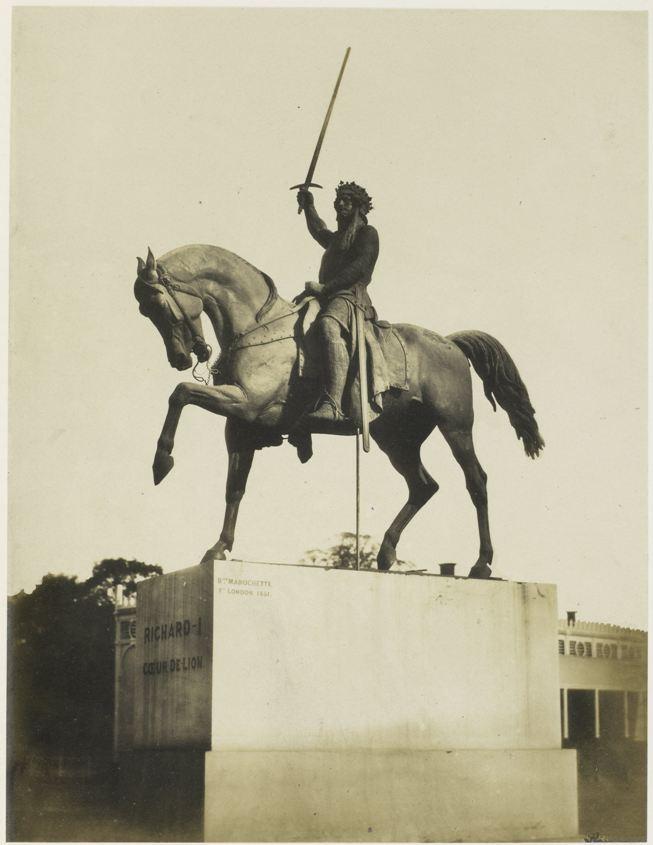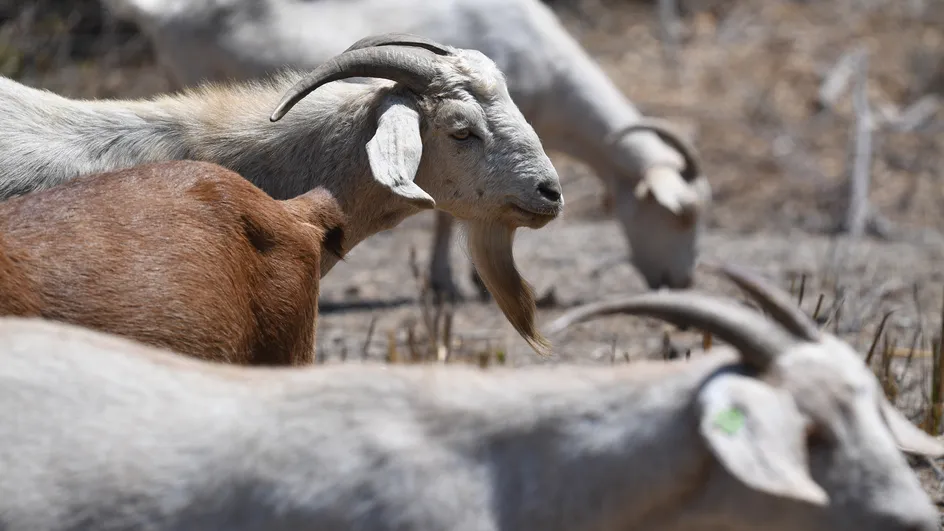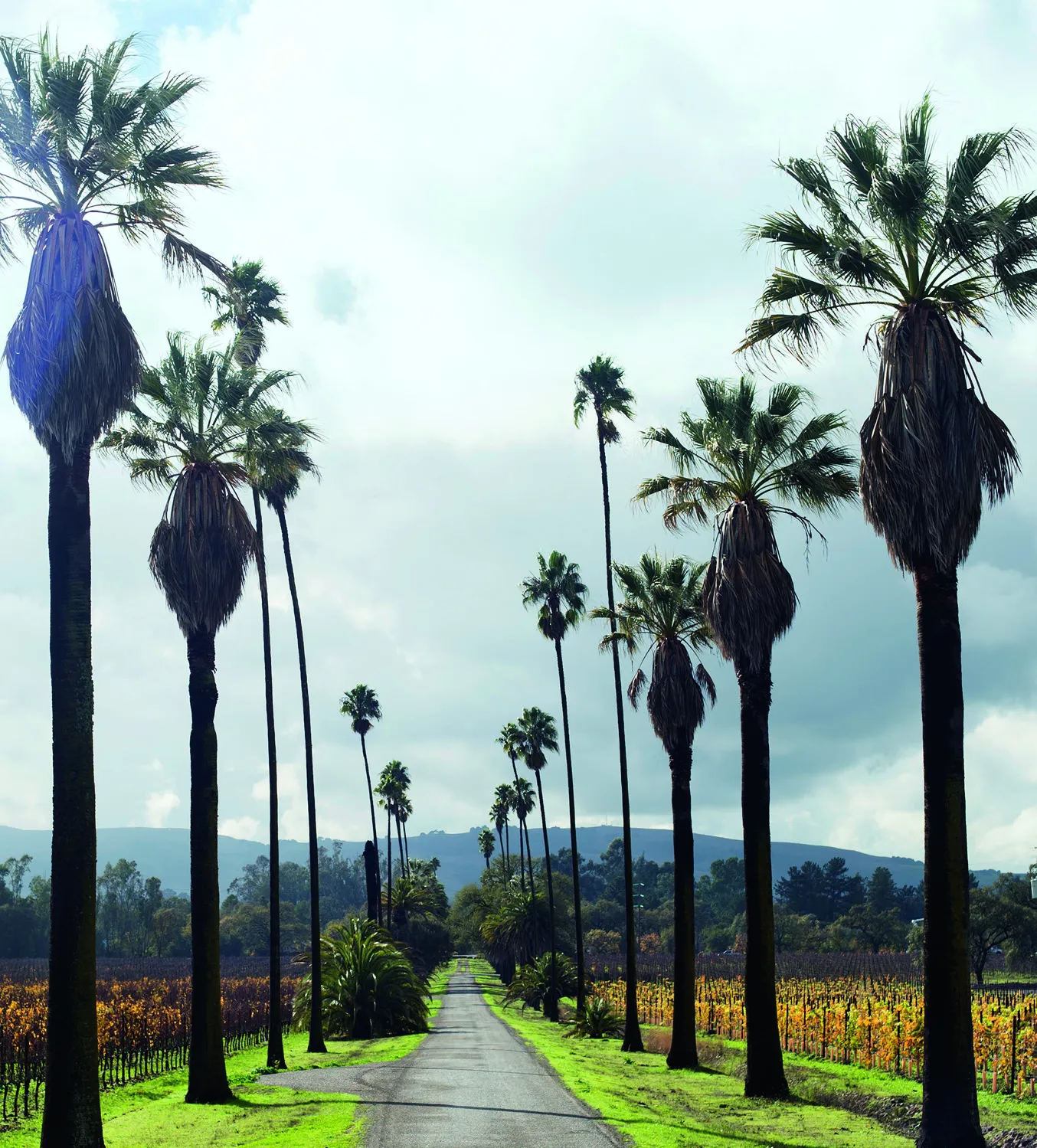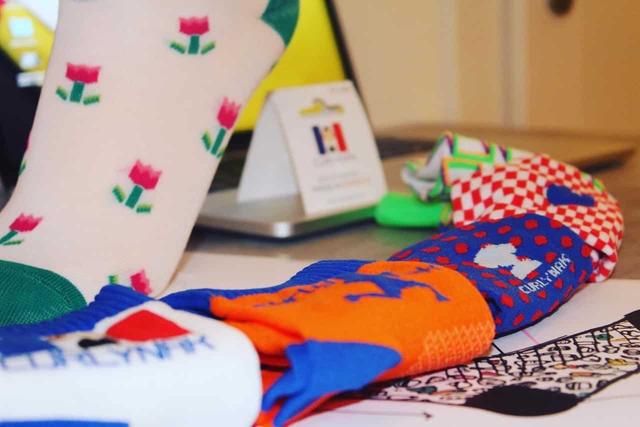Carlo Marochetti (1805-1867): from France to England, echoes of renowned
"This is Marochetti's work, one of the best sculptors in Paris.[1] Thus is expressed Chopin, in a letter he addressed from Nohant to his family on July 20, 1845, about the equestrian statue of the Duke of Orleans that we are erected in theLouvre courtyard.The musician continues: “Although his name is Italian, Marochetti is French;He has a very remarkable talent: all important work of this kind is entrusted to him."[2] Chopin exposes here in praise terms what the detractors of the sculptorre approve to the latter:" It is enough to be born outside our borders to be filled with favor and orders.[3] Important orders indeed since in less than ten years Carlo Marochetti will have contributed to two prestigious sites with major works: the Battle of Jemmapes (1834), Grand Bas-relief of the Arc de Triomphe, and the delightde Sainte Marie-Madeleine (1843), master altar of the Madeleine church in Paris.In France, Carlo Marochetti is at the height of glory, in the 1840s.A decade later, it is the Tour of England "London is the workshop of Marochetti" [4] proclaims the punch which, although satirical, nonetheless underlines the omnipresence of the sculptor in the London landscape[5].It seems relevant today to look at the notoriety of the sculptor since his home obtained in 2012 the label "Maison des Illustres" and thus seize the opportunity to put in parallel, in broad outline, his career in France,For the 1840s (more precisely 1838-1848), and in Great Britain (1850s) [6].In these two countries, the celebrity of the sculptor is associated with an equestrian statue: for the first, that of Emmanuel-Philibert, Duke of Savoie, who, although intended for Turin where she was erected in November 1838 on theCharles, was exhibited in the spring of the same year in the courtyard of the Louvre, then illustrated in the artist in 1839 (ill.1).
- 1. Marie-Alexandre Alophe (1811-1883)D’après Carlo Marochetti (1805-1867)Philibert Emmanuel de SavoieL’Artiste, Série 2, T1, 1839Photo : gallica.bnf.fr/BnF
- Voir l´image dans sa page
For the second, that of Richard Coeur de Lion [7], whose model in clay (ill.2) was pretentors of the first universal exhibition of 1851, "The Great Exhibition of the Works of Industry of All Nations", and the bronze erected before the London Parliament in October 1860.
- 2. Attribué à Claude-Marie Ferrier (1811-1889) et Friedrich von Martens (1806-1885)Modèle en argile de la statue équestre de Richard Cœur de Lion de Carlo MarochettiPhotographie, 1851Photo : Rijksmuseum
- Voir l´image dans sa page
The comparison does not stop there.Author of two binoculars equestrian statues of the Duke of Orleans (commanded one for Paris, the other for Algiers), Carlo Marochetti will realize those of Queen Victoria (1854) then Prince Albert (1863) for the city of Glasgow [8].With glory comes criticism, Carlo Marochetti, in the two countries, will find virulent detractors: Gustave Planche, Francis Turner Palgrave and ardent defenders: Louis Viardot, John Ruskin.While his father obtained French naturalization in 1815, he will always remain considered Italian and will be, on both sides of the English Channel, the object of xenophobic attacks.
Marochetti, model and fashionable sculptor
But it is in another aspect than that of criticism that we would like to consider the reputation of the sculptor because in the two countries it far exceeds the purely artistic framework.Thus, in 1844, the Journal des Caiffeurs, evoking a particularly talented streets of the streets, imagines him in turn poet, statesman, painter or sculptor.The comparisons are eloquent: "poet, [he] would have been m.Lamartine multiplied by M.Victor Hugo;statesman, m.Thiers and M.de Metternich at the same time;artist, m.Ingres and M. Decamps fondus ensemble, statuaire, il eût taillé la Vénus de Pâris, pour contraindre MM.Pradier and Marochetti to break their scissors. » [9]Ailleurs encore, le nom de Marochetti brille aux côtés de celui de Pradier, tous deux ont en effet, sous la plume d’Auguste Gautereau, le privilège d’être associés aux parangons de la sculpture grecque.The novel in question, the Pitou family which, if it has not marked the history of French literature, has at least the merit of evoking our two sculptors, ends with a fun image, that of Raymont statuary,Walking "happy, more happy than if he had been praxitel, Phidias, Marochetti or Pradier" [10].In 1844 again, the mercury of theaters, mentioned only Marochetti.Having wrongly attributed to Hippolyte Lucas a few verses cited in a previous issue, he corrects his error thanks to the intervention of the latter, which he comments with humor: "This communication has us, we do not fear to admit it, tender to tears. C’est Ambroise Thomas retrouvant un opéra de Mozart, Victor Hugo une tragédie de Corneille, ou Marochetti un marbre de Canova. » [11]
Quant à la chanson proposée par Jules Lagarde aux membres du Caveau sur le thème du bronze lors du banquet du 4 août 1843, Marochetti y incarne le bronze d’art, voici en effet le couplet consacré à ce domaine (les deux derniers vers constituant le refrain) : « Aux nobles chefs d’œuvre de l’art/Le bronze ouvre une large part/Tantôt des héros les plus dignes/Il éternise les insignes/Tantôt d’attributs élégants/Il orne le palais des grands/Marochetti, la gloire t’aiguillonne/Et voilà soudain le bronze qui résonne/ Voilà le bronze qui résonne.[12] A comment is essential in this regard;At that time, we speak a lot in the press of the two orders on which Marochetti is working "without worrying about it" [13]: the equestrian statues of Napoleon [14] and the Duke ofWellington [15], both in bronze, intended, one at the Esplanade des Invalides, the other in the city of Glasgow.Étienne Huard is indignant and wonders "how a rich artist, charged with such a job, can thus hurt the just French susceptibility, how he can have the courage to model two similar images![16].He concludes by exclaiming: "M.Marochetti will answer us with his works, and then we will know, by comparing Napoleon to Wellington, and the latter to Emmanuel-Philibert, if the artist is French, English or Italian;We will see it! ”[17] This arrest close to an indictment [18] will be recurrent in the career of Marochetti.Less aggressive and much more spiritual is the legend of a drawing proposed by the Charivari and censored: "Cosmopolitan baron and eclectic sculptor/Marochetti, for Paris or London,/of the same zeal at will and the grave of the great man, or the'Comic/ Polichinel image [19] Wellington.[20]
Rouen's newspaper rightly points out that it is for the allusion to "Polichinel Wellington" [21], and not for Marochetti, that this drawing was refused: "This drawing represented M.Marochetti the sculptor, in no way loaded with face, costume, attitude."[22] He adds that legend resumed" an idea dealt with in around twenty newspapers "[23], or rather" an observation of a proven fact, namely that M.Marochetti is responsible for both doing, and by the French government, the statue of the emperor, and by the English government, the statue of Wellington "[24].The load portraits that the Charivari announced to its readers for its funny mirror and among which was that of Marochetti had as authors Benjamin Roubaud and Charles-Joseph Traviès de Villers [25].
For his contemporaries, Chopin's letter testifies, Marochetti represents the archetype of the sculptor in vogue.Its name appears in fact, in popular, French and English literature, as a reference in terms of sculpture.Some characters from novels express the wish to entrust him with the realization of the desired work.Alexandre Dumas makes it speak to Château-Renaud, saved from an extreme danger: "When I am rich, I will have a statue of Chance by Klagmann or Marochetti."[26] On the other side of the Channel, Margaret Oliphant, thirty years later (1875), lends to his character, admiring the group formed by a mother and her child, an intention of the same order:" I would likethat Marochetti, or an artist of this caliber, be there to sculpt them in marble.[27]
At Charles Lever, the wish is less ambitious, it is simply for Lady Augusta to obtain a work of the famous sculptor: "Dad would be delighted to have a copy of the bust that Marochetti made of you" [28], butThe model is still the hero of the eponymous novel: Davenport Dunn.This novel, from 1859, appears that Marochetti's reputation is well established in the United Kingdom.The cited extract testifies to the success of the miniature busts that Marochetti then achieved, in his own Fulham RD (Sydney Mews) foundry, most often of marble busts, portraits of British high society personalities (Ill.3) [29].
- 3. Carlo Marochetti (1805-1867)Buste masculinBronze - 21,6 x 14cmRéduction d’un buste en marbre daté de 1849 Collection particulièrePhoto : C. Hedengren-Dillon
- Voir l´image dans sa page
Another facet of the sculptor's activity contributed to his notoriety, in 1851, of the trophies for the winners of prestigious horse races, the realization of which was provided by the goldsmith Charles Frederick Hancock (Ill.4).
- 4. Carlo Marochetti (1805-1867)Charles Frederick Hancock (1807-1891), orfèvreEntrée à Londres de Jean le Bon et du Prince NoirCoupe de Doncaster, 1853, détailArgent - 44cmDoncaster Museum and Art Gallery, AngleterrePhoto : C. Hedengren-Dillon
- Voir l´image dans sa page

A novel by James Payn [30] alludes to it, quoting a group of Marochetti as a reward awarded to the winner of the "Queen Prize", shooting competition organized in Wimbledon by the "National Rifle Association".
Model sculptor, Marochetti is also, in London, the fashionable sculptor in the workshop of which British high society rush and brand visitors.Among these, the American Octavia Walton Le Vert and the French Louise Colet offer us two detailed descriptions in which we find, in addition to precious indications concerning certain works, a double echo of this craze with regard to the sculptor.The first, July 5, 1853, said: "The baron, a very handsome man, is really one of the favorite sculptors of the English nobility;We see in his workshop a host of busts and statues of its members."[31] The second, five years later, evokes in the press a trip made in 1856 during which she visited" The workshops of the master, where the busts of the famous Lords and the most beautiful ladies "are renewed every day [32].
Marochetti and decor, fiction and reality
At Eugène Sue, Marochetti is part of the decor.In the living room of the Hotel d'Harville, "the frieze of the white marble fireplace and its two caryatids, of ancient beauty and exquisite grace, were due to the masterful chisel of Marochetti, this eminent artist having consentedto sculpt this delicious little masterpiece, no doubt remembering that Benvenuto did not disdain to model eiguières and weapons.[33] The allusion to the Grand Cellini was not to displease Carlo Marochetti, whose taste for the art of the Italian Renaissance is attested by his collections [34].In the description of the home of the rich Josiah Hardwicke by Amelia B.Edwards A marble group of Marochietti adorns one of the salons [35].But when the Irishman May Laffanfa say to one of his characters, commenting on the works of art adorning his home, including a "veiled virgin" of Marochetti: "He did it for me" [36], heThere is certainly confusion with the Milanese sculptor Raffaele Monti, established in London like Marochetti, whose veiled vestal was famous.It is however significant that this young novelist, born in 1849, retained the name of Marochetti in this novel published in 1876.We leave fiction with Marie Alexandre Dumas who evokes at the beginning of an autobiographical novel (1867) the game at which, at the age of nine, she had engaged, in the company of her friend Louise, in the apartment ofThe rue de la Chaussée d'Antin and which consisted in taking the place of the "two large bronze musketeers of Marochetti" [37].This is the pair of soldiers from Charles I, two figures of soldiers carrying tea towels (ill.5), also called the two soldiers wearing halberds, which Susse edited in three sizes (1 m, 70 and 45 cm) and of which Dumas therefore owned the largest model.
- 5. Carlo Marochetti (1805-1867)Susse, fondeur Deux figures de soldats portant des torchères,Bronze à patine dorée - 45cm Collection particulièrePhoto : C. Hedengren-Dillon
- Voir l´image dans sa page
As for the theater decor, it also happens that it is appreciated in terms of the work of the sculptor.So John W.Cole declares about the tank of Apollo in the representation of Shakespeare's winter tale by Charles Kean in 1856: "The horses were sculpted with vigor and a passion that would have done honor to Baron Marochetti in person.[38] The horses of Marochetti and the posture of his riders were so famous in England that we refer to it in the riding manuals of the time [39]!Finally, halfway between fiction and reality, we see in Jules Verne the hero of the steam house (1880), Colonel Edward Munro, whose wife was killed in India during the historic Dubibighar massacre (1857) inCawnpore (Kanpur), go and meditate in front of the memorial (ill.6) erected above the well where the victims, dead or lives were precipitated."There rises a colonnade in Gothic style, of octagonal shape.It surrounds the place where the well dug, whose orifice is now closed by a stone covering.It is a kind of base, which supports a statue of white marble, the angel of Pitié, one of the last works due to the chisel of the sculptor Marochetti.[40]
- 6. Samuel Bourne (1834-1912)Le Mémorial de Cawnporeavec l’Ange de la Résurrection de Carlo Marochetti (1805-1867)Photographie, 1865Photo : British Library’s Online Gallery
- Voir l´image dans sa page
The work [41], known as Angel of the Resurrection, angel of the Resurrection, is illustrated in the novel by Léon Benett (Ill.7).
- 7. Léon Benett (1839-1916)« Il tomba à genoux. »Illustration de La Maison à Vapeur de Jules Verne, chap.X Photo : gallica.bnf.fr/BnF
- Voir l´image dans sa page
Popularity of the work or the sculptor?Certainly both at the same time when Jules-Descartes Férat affixes on the two pillars framing the entrance to the cemetery of Père-Lachaise the two angels of Carlo Marochetti Quiy adorned the tombs [42] Bellini (on the left) and San Tommaso (on the right), thus proposing, with this drawing [43] unfortunately undated (ill.8), an imaginary decor to the glory of the sculptor and his angels.
- 8. Jules-Descartes Férat (1829-1898)Porte d’entrée du cimetière du Père-LachaiseCrayon et encre noire avec rehauts de gouache blanche - 18 x 15,30cmParis, Musée CarnavaletPhoto : Musée Carnavalet
- Voir l´image dans sa page
Marochetti, novel character?
Evoked as a "ideal" sculptor (Dumas, Oliphant) or through works of which he is lent to him (Sue, lifting), did Marochetti inspire one of his contemporaries a character of a novel?This is what Jan K suggests.Ostrowski. Après avoir souligné les points communs entre l’un des protagonistes de La Cousine Bette, le comte Wenceslas Steinbock, et l’artiste Piotr Michałowski : « artiste, Polonais, aristocrate, émigré après l’insurrection » [44] et les éléments rapprochant Marochetti et Michałowski, le professeurOstrowski fait remarquer que « l’époque de l’érection du monument de Steinbock (1841) et des critiques auxquelles il se heurte est identique, à un an près, à celle des attaques de la presse dirigées contre Marochetti après l’obtention de la commande et la présentation des premiers projets du monument de Napoléon (1840) » [45].He concludes by declaring: "We can therefore admit with a great probability that the two artists, Michałowski and Marochetti, had lent to Steinbock their features and fragments of their biography, and that the story of his aborted career is a literary transposition of eventsSurrounding the monument project for Napoleon.[46] Although Balzacian studies favor the name of Carle Elshoecht for the character of Steinbock [47], this interpretation deserves to be reported.Balzac knew Marochetti reputation, if not personally.Friedrich von Flotow remembers that at the chopin concert at whom he attended the Marquis de Custine (during the evening of May 8, 1838?) Were among the guests "Le Baron Marochetti, the sculptor, [...] the novelist Balzac[48].The novelist could not ignore the sculptor's setbacks concerning the tomb of Napoleon.Much later, in 1904, the name of Marochetti, barely disguised, appeared in the work of another famous novelist, Joseph Conrad, with a direct allusion to his notoriety: "You know by Crus Christi, the famous Italian sculptor.[49] Conrad, in his novel Nostromo makes this sculptor a reference in terms of art criticism, citing a statue of bishop with a broken nose, of which parrocheti made a big case, in an imaginary country in South America whereThe latter would have lived two years [50].George Frederick Masterman, in the autobiographical story that Conrad is inspired, evokes the name of the "Baron Marochetti" [51] about the English statuary Monygham [52] which, he says, was the assistant.Conrad, meanwhile, transforms the baron into a "knight" and offers us with his name a parody by assimilating him to parrots (parrochetti / parrots), allusion to South America where his novel takes place [53].The title of "Chevalier / Cavaliere" is not an invention of the writer or a transposition of the title of Baron.An English guide to northern Italy, published in 1842, indeed attributes to the "Cavaliere Marochetti" [54] The equestrian statue of Emmanuel-Philibert which he praised.Finally, the role conferred by Conrad to the "Cavaliere parrochetti", however minimal, is an echo revealing the credit granted from his time to the artistic judgment of Marochetti [55].Let us first quote this testimony in the press reporting, in 1859, a Titian bought by the second Duke of Wellington with this eloquent comment: "The fact that this acquisition was made on the advice of Baron Marochetti is sufficient to prove the value ofpicture."[56] More personal, the admission of John Everett Millais who, anxious of the reception of the paintings he exhibited in May 1856 at the Royal Academy, said he was reassured by what" Le Baron "says [57].Finally and above all, it should be noted that, when it comes to bringing together the collections of British Museum and the National Gallery, Marochetti is consulted, in the same way as the director of the National Gallery, Charles Lock Eastlake, or that the famousArt critic John Ruskin, auditioned the same day, April 6, 1857 [58].
The bust of Lady Constance Leveson Gower, a stage in the career of the sculptor
In France, as we have seen, the popularity of Marochetti is at its climax in the mid -1840s.She declined after the revolution of 1848 and her departure for England: "The Marochetti became common as a devil" [59] Persifles the Carillon, proving however that in 1853 the sculptor is still talked about in France in France.England takes over.During the Universal Exhibition of 1851, the colossal statue of Richard I, heart of Lion, placed at the western entrance to the Crystal Palace, inspires a poem at Dinah Mulock [60] and arouses the admiration of John Ruskin who will say toHer words that it is "an ideal work of the greatest beauty and value" [61].This statue, which Benedict Read chose to place on the cover of his book Victorian Sculpture (Yale University Press, 1984) also illustrates numerous tourist guides today, becoming a symbol of the city of London and England.In 1856, the reputation of Marochetti in London was at its height.During the Peace Festival organized on May 9 to celebrate the end of the Crimean War, four monumental works of the sculptor are presented: in addition to the Crimean War Memorial [62], then called "SCUTARI monument", destinedTo commemorate the soldiers who died on the field of honor and the peace trophy (missing work), which we both inaugurate that day, the equestrian statues (plaster) of Queen Victoria and Richardcœur de Lion are atHonor, in the center of Sydenham Crystal Palace.The press relates in detail the ceremony and engraving of the illustrated Times published on May 17, 1856 (ill.9) Complete the description made to it by the provision of the statues.
- 9. Illustrated Times, 17 mai 1856, p. 344-5La fête de la paix au Crystal Palace, le vendredi 9 mai 1856On distingue, à gauche, l’obélisque du Mémorial de la Guerre de Crimée et le Richard Cœur de Lion et, à droite, la statue équestre de la Reine Victoria devant le colossal Trophée de la Paix.Photo : D.R.
- Voir l´image dans sa page
Eight days later, the dramatic critic of the same newspaper, fell in love with actress Ruth Herbert, exclaims: "Ah!If I were Millais, I would paint it in my next painting in her dress of pure white silk, if I was Marochetti, I would make her a superb bust, and if I was munro, I would sculpt a lovely medallion of hisprofile.[63] Marochetti was famous for his "admirable female busts" [64] and British high society, as we have seen, rushed into his workshop.One of the young women of whom he portrained (1850), also posed for Alexander Munro, who represented it, in profile, in a medallion (1853) whose plaster copy is kept at the Grosvenor Gallery de Chester.There is also a portrait of her, in a "pure white" dress, but this portrait (1850) is not Millais but Winterhalter [65].We really have the impression, by reading the declaration of the dramatic critic of the illustrated Times that the latter has in mind these three portraits of Lady Constance Leveson Gower when he writes these lines and that it is not abouta simple coincidence.Daughter of the Duke and the Duchess of Sutherland, Francophiles and great protectors of the arts [66], Lady Constance, posed for many artists [67] before, then after her marriage in April 1852 with Hugh Lupus Grosvenor, future Duke of Westminster.The bust as the medallion were exhibited at the Royal Academy, respectively, in 1851 (n ° 1378) and in 1853 (n ° 1460) and it is, it seems, the only example of a model common totwo sculptors.The Bust of Marochetti (Ill.10) was in Stafford House, remains of the Sutherland, and was enthroned, decorated with jasmine flowers, the day of the wedding of the young woman [68].
- 10.Carlo Marochetti (1805-1867)Portrait en buste de Lady Constance Leveson-Gower, 1850Marbre - 70 x 50 x 27cm Collection particulièrePhoto : C. Hedengren-Dillon
- Voir l´image dans sa page
As for the portrait of Winterhalter [69], painted for Queen Victoria in July 1850, she commanded the copy to William Corden to offer it the same year as a Christmas gift to the Duchess of Sutherland [70].It is not impossible that Edmund Hodgson Yates, author of the "The Lounger at the Clubs" section of the illustrated Times and therefore of the article in question, noted this table during one of the countless receptionsorganized by the Duchess at Stafford House, where the whole of London was invited.In his Memoirs, Yates, if he does not mention this place, however evokes the beauty of Lady Constance and her mother.He also remembers the evenings spent, Friday, at the painter Abraham Solomon with many artists, including John Everett Millais, "young and beautiful as in the medallion that Alexander Munro had just finished" [71].It is therefore natural that the name of Millais is cited as a reference, especially since this artist, born in 1829, was considered, among the painters of the new generation, as one of the most promising.Alexander Munro, his four-year-old elder, by carrying out the medallion portrait of Lady Constance, the daughter of her benefactors [72], had said, launched the fashion of this kind of portrait [73].In his newspaper, Ford Madox Brown quotes Ruskin speaking of Munro and Marochetti "like of the two noble sculptors of England that the whole aristocracy supports" [74], this is the name of Marochetti, devoted and established sculptor, associated withnew to Munro's.At the same time, a contemporary and friend of the latter, the sculptor Thomas Woolner, in a fun caricature [75] by Dante Gabriel Rossetti (Ill.11), is represented seated in front of a prosperous, standing marochetti, with, in his back and his feet bags filled with money.The two men challenge each other but the divine, giant eye, emerging from the smoke escaping from the Woolner pipe, fixes itself on Marochetti which we see, in the background, the Richard Coeur de lion.
- 11. Attribué à Dante Gabriel Rossetti (1828-1882)Thomas Woolner and Baron Marochetti, c.1856Crayon et encre brune - 11,2 x 17,8 cm Rossetti ArchivePhoto : Rossetti Archive
- Voir l´image dans sa page
- 12. Carlo Marochetti (1805-1867)Mémorial de la Guerre de Crimée, 1856-58Cimetière anglais, HaydarpaşaÜsküdar (Scutari), Istanbul, TurquiePhoto : C. Hedengren-Dillon
- Voir l´image dans sa page
The presence of the Obélisque de Scutari (Ill.12) in close-up, on the right of the drawing, allows you to date this one from 1856.If it does not have to develop more here the links between the pre -raphaélites and Marochetti, which Woolner considered as a rival, it is also undeniable that this caricature does not confirm the success of Marochetti and its notoriety.But let's go back to the quote from the illustrated Times.If, as it is allowed to believe, she refers to the three portraits of Lady Constance, she indirectly emphasizes the role played by the Sutherland in the career of Marochetti."Mistress of the Robes [76]" of Queen Victoria, the Duchess of Sutherland was also her friend.It was to her that in July 1848 the Queen, very satisfied with Marochetti's work (it is Prince Albert's bust), confides her first impressions [77].It therefore seems that the duchess was at the origin of the presentation of the sculptor to the queen [78].The Sutherland had indeed been able to meet Marochetti between 1841 and 1844 when he went to Scotland for the statue of the Duke of Wellington.The bust of their daughter Constance, made at the start of the sculptor's British career, may have launched the sculptor's vogue in British high society.Octavia Walton Lever, visiting Stafford House on July 8, 1853, remarked there "a lovely marble bust of Lady Constance Grosvenor by Baron Marochetti" [79].The one Louise Colet [80] distinguished in the workshop in 1856, from that of the famous Swedish singer Jenny Lind [81] (ill.13) is most certainly the bronze reduction, the sculptor had indeed kept a copy, preserved by his descendants (ill.14).
- 13. Carlo Marochetti (1805-1867)Portrait en buste de Jenny LindBronze - 32 cm (avec socle)Photo : D.R.
- Voir l´image dans sa page
- 14.Carlo Marochetti (1805-1867)Portrait en buste de Lady Constance Leveson-GowerRéduction en bronze - 20,5 x 13,4 cm Fonds MarochettiPhoto : C. Hedengren-Dillon
- Voir l´image dans sa page
The funerary monument of Princess Elizabeth Stuart (1856)
Five works by Marochetti were exhibited in 2010 in Buckingham Palace during the very beautiful exhibition dedicated to the patronage of Queen Victoria and Prince Albert [82].Among these, testimony of the interest that the royal couple had in this work, a reduction of the Richard I, heart of Lion [83], offered by Queen Victoria to Prince Albert for her birthday on August 26, 1853, thevery year of the subscription in favor of the erection of the statue, to which they had one as the other generously contributed.Another royal order [84] must be mentioned in the context of this article due to the popularity that the monument has known, illustrated by quantity of stereoscopic photographs (Ill.15) [85], and of the interest it still arouses, to judge by its success on the web.It is the funeral monument of Princess Elizabeth Stuart (1856), daughter of King Charles I, erected in the church of Newport on the island of Wight (Ill.16).
- 15. AnonymeTombe de la princesse Elizabeth par Marochetti, c. 1860Photographie stéréoscopique - 17,2 x 7,73 cmCollection particulièrePhoto : DR
- Voir l´image dans sa page
- 16. Carlo Marochetti (1805-1867)Monument funéraire de la Princesse Elizabeth Stuart, 1856, détail,Église St Thomas, Newport, île de Wight, AngleterrePhoto : C. Hedengren-Dillon
- Voir l´image dans sa page
It is good to evoke it here through the testimony that Louise Colet contemplates us contemplating the recruitment of Elizabeth who was still, during her visit (summer 1856), in the workshop of Marochetti: "But it was above allA statue of white marble, a statue of a young girl lying and seeming to sleep, which moves me and delights me.This statue that a tomb was waiting for was that of Charles I's daughter, who died at fourteen.I hugged the big statuary, and I won this visit an impression that did not erase.The next day, I was leaving for Wight Island.[86] The story of the stay of the poet in Wight, we find it in his famous children's book.Visiting the castle of Carisbrooke where the young princess ended her days, she exclaims in response to the little goalkeeper who announces that the whole island will soon glorify the memory of Elizabeth Stuart with the inauguration of the monument commissioned by theQueen: "This statue, I saw her!She is the young princess when she found her dead, stretched white and modest in the folds of her garment.The head, of ideal beauty, rests on the open Bible;The hair shade the neck, breast and arms: it is a chaste and divine figure that suits a tomb;The soul hovers there on a transfigured body.This figure is the work of Marochetti.[87]
Marochetti's reputation: semantics and posterity
"Famous", "big", "eminent", the epithets qualifying the sculptor are rare in the French press, during the lifetime of Marochetti.Much more varied and frequent are the adjectives on the English side: "Great", "Famous", "Well-Known", "Celebrated", "Eminent", "Distinguished", "illustrious" ... as for its statues, they are considered as"Majestic", the press relating the marriage of the Prince of Wales, even depicts firefighters "as majestic as the statues of Baron Marochetti" [88].This imbalance is found in the necrological notices.In England, the sudden death of the sculptor on December 29, 1867 arouses long articles, and the columns devoted to him the Times are particularly elegant.In France, on the other hand, the few lines mentioning his death go almost unnoticed.Only Paul Mantz, in the illustration, is surprised that we can "forget so quickly an artist who we have talked about once, and who, famous in Italy, in France, in England, had been able to organize the multiplicity at his benefitof the homelands ”[89].It is in the chapter that he devotes to English sculpture that Louis Viardot, emphasizing, like Times [90] and illustration the triple identity of the sculptor, also famous for the memory of Marochetti in a work published shortly after deathof the latter: “He is an Italian artist, raised in France, M.Marochetti, who held in London, in the statuary, the high rank that no rival was disputed to him.Death has just removed it from its adopted country."[91] Marochetti When the" National Gallery Site Commission "questions her, insists on the importance of art:" Architecture, painting and sculpture are the framework of an era, (...) they addmany in the importance of a country, its reputation and its influence.[92] Three of the sculptures he left, and which can be considered as his masterpieces, remain emblematic of the places where they are and the countries with which his name is associated: Emmanuel-Philibert inTurin, the master altar of the Madeleine church in Paris and the Lion Coeur Richard in London.But who, apart from some art historians, knows today that it is the works of the same sculptor?







